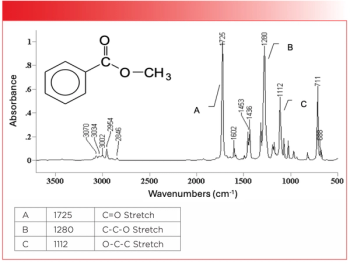
- January 2025
- Volume 40
- Issue 1
- Pages: 16–19
The Big Review IV: Hydrocarbons
In the fourth installment of our review of infrared spectral interpretation, we will discuss the spectroscopy of hydrocarbons. We will look at the stretching and bending vibrations of methyl (CH3) and methylene (CH2) groups, how to distinguish them, and how to know whether one or both of these functional groups are present in a sample. We will also discuss aromatic hydrocarbons, specifically the C-H stretching and bending peaks of mono- and disubstituted benzene rings, and how to distinguish them.
In the fourth installment of our review of infrared spectral interpretation, we will discuss the spectroscopy of hydrocarbons. We will look at the stretching and bending vibrations of methyl (CH3) and methylene(CH2) groups, how to distinguish them, and how to know whether one or both of these functional groups are present in a sample. We will also discuss aromatic hydrocarbons, specifically the C-H stretching and bending peaks of mono- and disubstituted benzene rings, and how to distinguish them.
Hydrocarbon molecules, by definition, only contain carbon and hydrogen. Given that this family of molecules contains only two chemical elements, you may think it is a small family, but, courtesy of the richness of carbon’s chemistry, this is not the case. In this review, we will focus on the spectroscopy of methyl (CH3) and methylene (CH2) groups, which are frequently found in alkyl chains. There are many different types of aromatic hydrocarbons, but our focus here will be on mono- and disubstituted benzene rings because they are perhaps the most common aromatic compounds.
Methyl and Methylene Functional Groups Review
The column where the spectroscopy of the C-H bond was first introduced was the second one I ever wrote, back in April 2015 (1). Please review that column for a detailed description of the structure, nomenclature, and spectroscopy of the methyl (CH3) and methylene (CH2) functional groups. This column is meant as a refresher on these topics.
The structure and C-H stretching vibrations of the methyl group are seen in Figure 1.
The CH3 functional group is three-dimensional, so it is difficult to illustrate in two dimensions. In Figure 1, the top C-H bond in each molecule points away from you out of the plane of the page, and the symbol used to denote this is called a hash bond. The leftmost hydrogen in each methyl group points towards you out of the plane of the page, and the symbol used to denote this is called a wedge bond.
The vibrations illustrated in Figure 1 are the asymmetric and symmetric C-H stretches of the methyl group. The asymmetric stretch is so named because the symmetry of the molecule is broken during the vibration. Note that as one C-H bond moves toward the carbon atom, the other two move away from it, thus breaking the symmetry. For the methyl group to the right in Figure 1, all three hydrogens move in phase with each other, either towards or away from the carbon; therefore, the symmetry of the functional group is not broken.
Unlike the methyl group, the CH2 group is planar, as seen in Figure 2, where the carbon atom and the two hydrogens are in the plane of the page. There is a hash bond pointing towards a carbon atom behind the plane of the page, and a wedge bond pointing towards a carbon atom pointing out of the plane of the page. Like the methyl group, the methylene group has symmetric and asymmetric stretches. Again, note that for the symmetric stretch, the two hydrogens move in the same direction, maintaining the symmetry of the molecule, whereas for the asymmetric stretch, the hydrogens move in opposite directions, breaking the symmetry of the molecule.
Recall (2) that I coined the phrase group wavenumber to denote the diagnostically useful peaks that are essential in identifying the presence of a given functional group in a sample. Recall that the properties of a good group wavenumber peak are that it be intense, in a unique wavenumber region where it is not interfered with by peaks from other functional groups, and have a wavenumber position that does not move around much from molecule to molecule. The C-H stretch group wavenumbers for methyl and methylene groups are shown in Table I (1).
The ±10 cm-1 range for each group wavenumber seen in Table I is the range in which these peaks are found across a large number of molecules. This is a relatively narrow range compared to other group wavenumbers we have and will study. However, as with all things in infrared spectral interpretation, there are no absolutes, and every peak position range I give you will have exceptions.
The peaks in Table I fall between about 3000 and 2850 cm-1 (going forward, all peak positions will be given in cm-1 units, even if not otherwise noted). In this range, the methyl group has two peaks at 2962±10 and 2872±10, and the methylene group has two peaks at 2926±10 and 2855±10. We can take advantage of this fact to help us figure out whether a sample contains methyl groups only, methylene groups only, or both.
One of the things I have emphasized in this column series is that infrared spectral interpretation is an exercise in pattern recognition, and that, upon initial examination, you should scan a spectrum with your eyes from left to right, looking for peak patterns that disclose the presence of specific functional groups (2). A quick count of the number of significant peaks in the 3000 to 2850 range is useful, as seen in Table II.
If there is one peak (rare) or two peaks in this region, the sample contains either methyl or methylene only, because each of these functional groups has two peaks between 3000 and 2850. If there are three or four peaks in this region, the sample must contain both CH3 and CH2, because each of these by themselves only has two peaks.
In addition to stretching vibrations, functional groups also have bending vibrations. Figure 3 shows the symmetric bend of the methyl group, and the rocking vibration of the methylene group.
I will refer to the symmetric bend of the CH3 group as the umbrella mode because the three C-H bonds bend in the same direction towards and away from you, like the opening and closing of an umbrella. This peak typically falls at 1375±10, and is rarely seen outside this range. Imagine for the CH2 rock of the methylene group that the two hydrogens rock left and right in-phase around the carbon-carbon bond axis like a rocking chair. as seen in Figure 3. This peak falls at 720±10 and has a special property. The CH2 rock only appears in a spectrum if there are four or more methylenes in a row. Thus, the ethyl, propyl, and butyl alkyl chains do not exhibit this peak, but pentyl groups or longer will. This peak is then useful since its presence or absence tells us something about alkyl chain length. For more on this topic of determining alkyl chain length from infrared spectra, please refer to one of my past columns (3).
Aromatic Hydrocarbons: Mono and Di-Substituted Benzene Rings
We discussed the definition of an aromatic molecule previously (4). So far in this column series, we have limited our discussion of the spectroscopy of aromatic molecules, for simplicity’s sake, to mono- and disubstituted benzene rings (5). Figure 4 illustrates the structure of these four molecular types.
The leftmost molecule in the figure is methyl benzene, or toluene, an example of a mono-substituted benzene ring. The other three structures in Figure 4 are structural isomers of xylene (dimethyl benzene). Structural isomers are molecules that have the same chemical formula but different chemical structures. Note that for the ortho isomer of xylene, the two methyl groups are on adjacent carbons, for the meta isomer they are separated by one carbon, and for the para isomer, the pair of methyl groups is separated by two carbons.
Recall (5) that, to distinguish mono- and disubstituted benzene rings from each other, we depend upon the position of the C-H wagging vibration peak between 1000 and 700, and the presence or absence of the ring bend peak at 690±10. These patterns are illustrated in Figure 5.
Note that for mono-substituted rings, the ring bend is present, and in the example, the C-H wag falls at 728. In general for mono-substituted rings, this peak falls from 770 to 710. For orthosubstituted rings, note that the ring bend peak is absent, and only the C-H wagging peak is seen. The C-H wag for ortho molecules typically falls from 770 to 735. The pattern of peaks that defines the presence of a meta molecule in a sample is the presence of the C-H wag from 810 to 750 and the ring mode. Lastly, note that para molecules do not exhibit the ring bend peak, and that in general, their C-H wag falls between 860 and 790. As we go from left to right then in Figure 5, the pattern is two peaks, one peak, two peaks, and then one peak. All this information is summarized in Table III.
In my experience, when trying to distinguish substituted benzene rings from each other, it is best to look for the ring bend peak first since its message is clear, it is either present or absent, and then use the C-H bending peak position to finalize your analysis.
A close reading of Table III shows it is not foolproof. For example, if a spectrum has a ring bend peak and if the C-H wag falls between 770 and 750, the table says the molecule could be mono or meta. To solve this problem, consult the “benzene fingers” peaks discussed previously (6).
Please take a moment to review Tables I and III. In my 30+ years as an interpreter of mid-infrared spectra, these are the two tables I use most often. This is because almost inevitably every sample I encounter contains a CH3 group, a CH2 moiety, or a substituted benzene ring. I generally discourage infrared interpreters from memorizing peak positions, but Tables I and III are so important that they are worth remembering, or at least practicing with them until you remember them.
Conclusions
Both methyl and methylene groups have C-H stretching peaks between 3000 and 2850. The number of these peaks present in this range discloses whether a sample contains methyl, methylene, or both. Mono- and disubstituted benzene rings can be distinguished by the position of the C-H wagging peak and the presence or absence of the ring bend peak. All this information is summarized in Tables I and III, perhaps the two most important summary tables in infrared interpretation.
References
(1) Smith, B. C. Electromagnetic Radiation, Spectral Units, and Alkanes. Spectroscopy 2015, 30 (4), 18–23.
(2) Smith, B. C. A Process for Successful Infrared Spectral Interpretation. Spectroscopy 2016, 31 (1), 14–21.
(3) Smith, B. C. How to Properly Compare Spectra, and Determining Alkane Chain Length From Infrared Spectra. Spectroscopy 2015, 30 (9), 40–48.
(4) Smith, B. C. Group Wavenumbers and an Introduction to the Spectroscopy of Benzene Rings. Spectroscopy 2016, 31 (3), 34-37.
(5) Smith, B. C. Distinguishing Structural Isomers: Mono- and Disubstituted Benzene Rings. Spectroscopy 2016, 31 (5), 36–39.
(6) Smith, B. C. The Benzene Fingers, Part II: Let Your Fingers Do the Walking Through the Benzene Fingers. Spectroscopy 2016, 31 (9), 30–33.
Articles in this issue
Newsletter
Get essential updates on the latest spectroscopy technologies, regulatory standards, and best practices—subscribe today to Spectroscopy.





